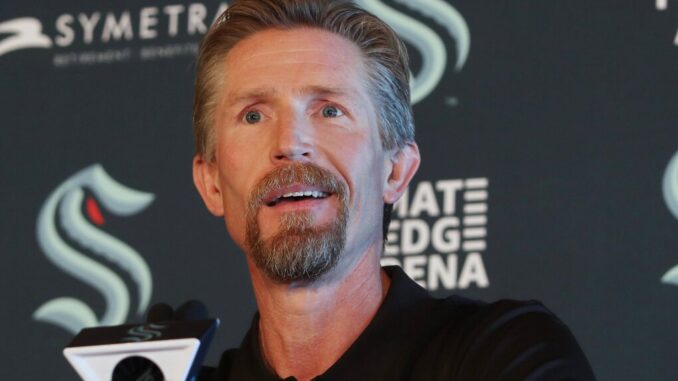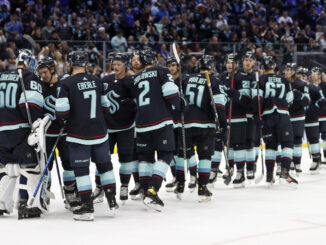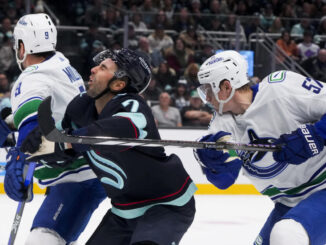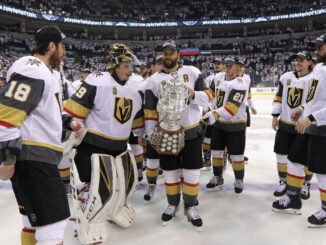
Last Thursday, the Seattle Kraken formally announced the hiring of the first-ever head coach in franchise history, former Philadelphia Flyers bench boss and Toronto Maple Leafs assistant, Dave Hakstol.
As ex-Arizona coach Rick Tocchet had emerged as the frontrunner for the position in recent weeks, the appointment certainly caught fans and media members off guard, with some unsure of whether Hakstol was the most inspired choice given who was available on the market.
His tenure with Philadelphia, which ran from the 2015-16 campaign to around the halfway mark of the 2018-19 season, saw the Flyers compile a regular-season record of 134-101-42 and qualify for the postseason twice during Hakstol’s 3 full seasons in charge.
Using data compiled by the advanced statistics website Natural Stat Trick, we can see how Hakstol’s teams stacked against the rest of the league and what type of play style the Kraken might adopt under their new coach.
For this exercise, I’ll be using the 2015-18 seasons as Hakstol was fired after only 31 games in 2018-19, and the three full seasons should offer a fairer assessment of his tenure.
Responsible Defensive Strategy
Over the three seasons, Hakstol’s Flyers ranked within the top third of the league in the rate at which they prevented unblocked shots against and expected goals against at even strength, a metric that roughly gauges the quality of chances based on the location of the shot, that their opponents were able to create.
Further, their attention to detail and collective buy-in to work hard at both ends of the ice also resulted in Philadelphia being adept at keeping their opponents to the perimeter in attack, rather than allowing them to waltz into high-danger areas near the slot.
In a sport as random as hockey (they play on a slippery ice surface batting around miniature rubber disks, remember), a hot- or cold streak of shooting or goaltending can be the difference between making a deep playoff run and hoping for your number to be called at the draft lottery.
If the process is sound and a structure is in place as they appear to be with Hakstol, the results will follow.
Dynamic Power Play
At first glance, you might be wondering how a power play that converted on just under 20 percent of its chances over three seasons (15th in the NHL) could be considered dynamic. But, in terms of the chances that the special teams unit created, they ranked among the league’s elite.
Using the previously mentioned expected goals metric, Philadelphia managed to generate the third-highest rate of shots taken and expected goals per 60 mins in the league over a three-year period, meaning that they constantly threatened their opponents on the man advantage.
Unfortunately, their ability to fashion quality scoring chances did not translate into goals, as the Flyers also posted the 4th worst shooting percentage in the NHL during Hakstol’s tenure. Unlucky? Or simply not good enough to capitalize? It’s tough to say.
It should be noted that Hakstol had offensive weapons such as Claude Giroux and Jakub Voracek at his disposal. Still, the Kraken should accumulate enough skilled forwards that they can reproduce the blueprint for the Flyers’ power-play prowess.
However, a clinical shooter may be required to overcome their finishing woes.
Trust in Youth
The presence of stringent rules and meddlesome contract clauses will undoubtedly force franchises around the league to make difficult decisions regarding their expansion protection lists, ensuring that the Kraken should have their pick of several promising but unproven skaters looking to cement an NHL roster spot next season.
The emphasis on youth meant that players such as Sean Couturier, Ivan Provorov, Travis Konecny, and Shayne Gostisbehere were key contributors to the Flyers’ success in their under-25 seasons during Hakstol’s reign in the City of Brotherly Love. In a pressure cooker as scathing as the city of Philadelphia, this extension of trust is telling of Hakstol’s philosophy.
Before his time with the Flyers, Hakstol’s held the head coaching position with the University of North Dakota from 2004 to 2015, leading the Fighting Hawks to seven NCAA Frozen Four berths in that time and while consistently being named a finalist for the collegiate coach of the year.
Over those 11 seasons, Hakstol oversaw the development of several future NHL mainstays, including Travis Zajac, T.J. Oshie, and Jonathan Toews, further lending credence to his reputation as a nourishing incubator for young talent.
The Verdict
Hakstol’s resume suggests that there will be a cohesive game plan centered around defensive accountability augmented by the nurturing of Seattle’s stars of tomorrow. While it would be nearly impossible to replicate the success of Vegas’ inaugural season, the Kraken should ice a lineup chock full of exciting pieces eager to prove their mettle in the big leagues.




